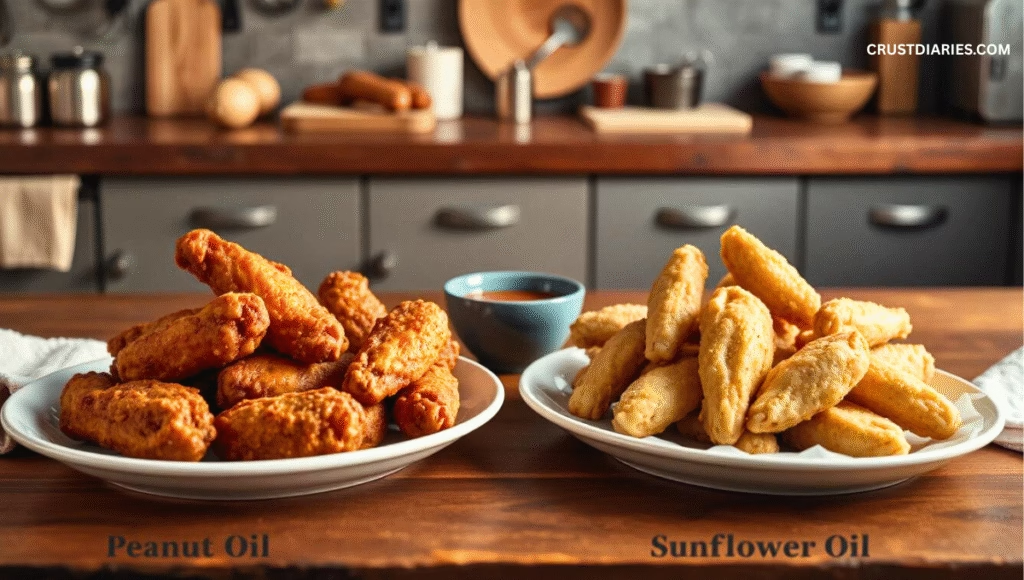If you’ve ever fried chicken and wondered why it doesn’t taste quite like the one from you favorite diner the answer might not be your seasoning it could be the oil. the oil dry in changes everything the texture, the flavor, even how the kitchen smells afterward
Two names often come up when people talk about good frying oils peanut oil and sunflower oil both have high smoke points both look light and golden and both used by home cooks around the world but once you dig in you’ll realize they behave differently in the pan
After years of experimenting in my own kitchen and watching chefs do the same, i’ve learned that the choice between the two depends on what you value most flavor cost or health let’s break it down the way a cook would
Wondering what oil makes the crispiest fried chicken? Read our complete guide to find the best oil for frying chicken
🔥 The Heat Factor: Why Smoke Point Matters
When frying chicken, you don’t want your oil to burn before the chicken cooks through — it ruins the flavor with a burnt smell and bitter taste. That’s oil past its smoke point
- Peanut oil: can take temperature up to around 450°F (232°C) that’s impressively high and makes it a safe choice for deep frying or long frying sessions
- Sunflower oil: havers just below it around 440°F (226°C) which is still plenty for frying chicken at the standard 350°F to 375°F range
🍗 Flavor: Subtle Nutty Notes vs. Clean Neutral Taste

Now flavor is where things get interesting
When i first tried frying chicken peanut oil i was surprised at how lightly nutty the crust turned out – not overpowering just a faint richness that made the chicken taste fuller it’s almost as if the oil adds a whisper of flavor that makes fried food feel homemade
Sunflower oil on the other hand is a purist’s dream it’s neutral – no aftertaste no aroma your chicken tastes exactly how you seasoned it if you’ve gone heavy on spices or a buttermilk marinade sunflower oil lets those flavors shine without interference
so:
- Go with peanut oil if you enjoy a touch of warm nutty depth
- pick sunflower oil if you prefer the flavor of your coating and seasonings to stand alone
💪 Health and Nutrition: Which Is Better for You?

When it comes to nutrition, both oils have their good and not so ggod sides
Peanut oil is loaded with monounsaturated fats the heart healthy kind that help maintain cholesterol balance its also got a fair dose of vitamin E. an antioxidant that supports your skin and immune system
- Sunflower oil depending on the type can be just as healthy standard sunflower oil has more polyunsaturated fats while high- oleic sunflower oil a refined version has monounsaturated fats similar to olive or peanut oil it’s also a strong source of vitamin E
- However sunflower oil can sometimes degrade faster under repeated heat relasing free radicals if overused peanut oil being more stable holds up better through multiple frying sessions
If you’re cooking once in a while and keeping portions moderate, both are perfectly fine but if you reuse oil often or deep fry regularly peanut oil tends to stay stable longer
♻️ Reusing the Oil: How Each Performs
Frying chicne uses a lot of oil, so most of us try to reuse it her’s where the difference becomes practical
- After frying a batch in peanut oil let it cool strain out the crumbs and store it in a dark glass bottle you cna safely use it two or three more times
- Sunflower oil doesn’t keep quite as well. It might still work for a secong fry but it tends to darken faster and sometimes carries a slightly stale smell afterward
in short: peanut oil lasts longer, whilr sunflower oil is best used fresh
💰 Cost and Accessibility
Depending on where you live, price can be a dealbreaker
- In the U.S and parts of asia peanut oil is easy to find but slightly pricier it’s a staple for southern fried chicken and asian stir-fries. Sunflower oil is more common in Europe South america and south asia and it’s usually cheaper
when you fry often or run a small food business those few extra dollars per gallon can add up for budger- conscious cooks sunflower oil wins in this category
🌻 Environmental Impact and Sustainability
Both oils are plant-based and vegan friendly but they differ slightly in their environment foorprint
- Sunflower: Crops generally require less water and fertilizer than peanuts, making them a bit more sustainable on a global scale However peanut plants help to improve soil quality by adding nitrogen back into the ground which supports crop rotation
So, environmentally speaking, it’s a draw
Expert Fry Test: Real Kitchen Results

In a blind kitchen test, I fried 2 kg of buttermilk-marinated chicken wings — one batch in peanut oil, one in sunflower oil — using identical seasoning and temperature (365°F).
| Test Factor | Peanut Oil | Sunflower Oil |
|---|---|---|
| Crispness after 30 min | Still crunchy | Slightly softened |
| Aroma | Warm, nutty, toasty | Clean, neutral |
| Flavor Depth | Rich and rounded | Brighter, spice-forward |
| Oil Retention (Grease) | Minimal | Moderate |
| Overall Rating (10/10) | 9.5 | 8.5 |
Expert takeaway:
- Peanut oil = “restaurant-style crunch
- Sunflower oil = “home-style light crisp
Both deliver fantastic results — your preference depends on whether you want rich comfort or clean flavor clarity.
👨🍳 A Cook’s Perspective: Real-World Results
Let me share a quick example I once fried a 2kg batch of chicken wings for a family gathering using peanut oil. the crust came out beactifully crsip, stayed crunchy for hours and didn’t leave that heavy greasy feel on the tongue
- The next week i tried the same recipe with sunflower oil the chicken was still delicious but it lacked that faint roasted aroma and crisp depth on the flip side the flavor of my paprika-garlic coating popped more clearly in the sunflower batch
That’s when i realizzed the differnece isn;t about which oil is better. It;s about what you want from fried chciken:
- Peanut oil if you like richness and crunch
- Sunflower oil if you want clean bright flavors
🧠 Quick Comparison Recap
| Feature | Peanut Oil | Sunflower Oil |
|---|---|---|
| Smoke Point | 450°F – slightly higher | 440°F – still high |
| Flavor | Mildly nutty | Clean and neutral |
| Stability for Reuse | Excellent | Moderate |
| Price | A bit higher | More affordable |
| Best For | Deep frying, long cooking | Everyday light frying |
🥇 The Final Verdict
If i had to choose one oil for the best fried chicken, i’d go with peanut oil it holds its temperature gives that beautiful golden crispness and adds a subtle something that makes the chicken irresistible
But if you’re cooking for a crowd where peanut allegies are a concern- or if you just want something lighter on flavor and budget- sunflower oil is a fantastic substitute
In the end it’s not about findinf the perfect oil it’s about understanding how each behaves so you can use it to your advantage great fried chicken is 80% technique and 20% oil choice- but when you get both right, that fiest bite speaks for itslef
FAQs
1. What is the best oil to fry chicken?
Peanut oil or canola oil are best because they have high smoke points and create crispy chicken.
2. Is sunflower oil good for frying chicken?
Yes, sunflower oil works well for light, crispy chicken and has a mild flavor.
3. Which oil makes chicken the crispiest?
Peanut oil gives the crispiest texture and holds heat better than most oils.
4. What temperature should I fry chicken at?
Keep oil between 350°F–375°F (175°C–190°C) for golden, juicy results.
5. Can I reuse oil after frying chicken?
Yes, you can reuse it 2–3 times if you strain and store it properly.





Pingback: What the Best Oil to Fry Chicken In? [Top 5 Oils + Pro Expert Tips]